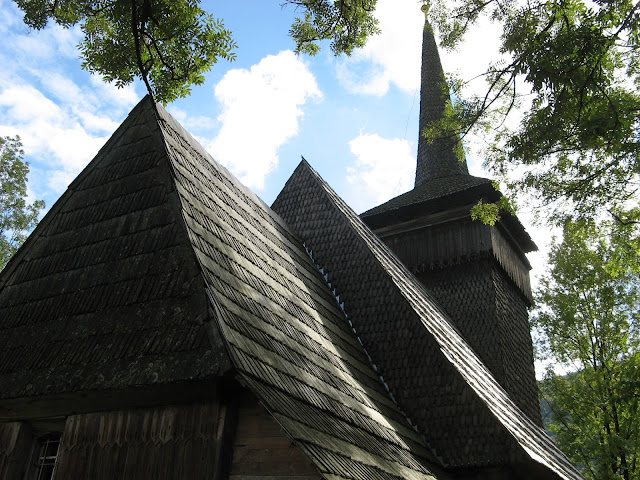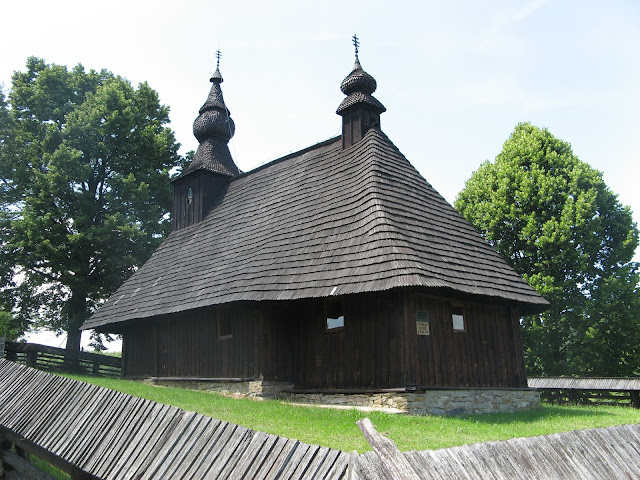- A Little Local Flavour
- Amazing Architecture
- Beautiful Towns
- Best of Country Lists
- Classic Castles
- Day Trips
- Essential Travel Destinations
- Folk Culture Destinations
- Natural Wonders
- Panoramic Views
- Photo Challenges
- Quirky and Unusual Sights
- Remarkable Relics of Communism
- Surprising Signs
- Wooden Churches of the Carpathians
Wednesday, October 21, 2015
Wooden Churches of the Carpathian Mountains # 40 - Nehrovets, Ukraine
Nehrovets is a small village in the Zakarpattya region of western Ukraine, close to the larger village of Kolochava and 40 kilometres north of the small city of Khust. The church stands on a low hill above the central part of the village, with tall trees making it hard to see from the road. Views of the peaks and ridges of the Carpathian mountains to the north make an impressive backdrop for the church and separate wooden bell tower.
The church is dedicated to Saint Michael the Archangel and was built during the eighteenth century. It is constructed primarily of spruce wood. The floor plan of the church features three rooms and there are three distinct roof lines above, making it an example of the Boyko architectural style. The height of the tower and the steeple above it dominate the structure, yet the overall design retains well-balanced proportions. An inscription indicates that in 1918 the church was moved to the present location and received a new roof and tower at that time.
The church interior contains a modern iconostasis and icons, though several historical icons from the 18th century have also been preserved. A large two-storey bell tower stands at the top of the steps leading up from the road. The bell tower has a shape which is typical for the 'Verkhovina' highlands of this region, though it is in a much better state of preservation than most others. A modern wooden church stands beside the historical one and serves as the main place of worship for the local villagers.
Nehrovets is difficult to reach by public transport, the best option is to walk the two kilometres along the road from the neighbouring village of Kolochava which has limited bus and marshrutka connections to Khust. In the morning marshrutkas also go from Nehrovets to the nearby town of Mizhhirya. The road through the village is paved but it is not in good condition. The keeper of the church keys lives across the road from the church, though I was unable to locate them during my visit.
Monday, October 19, 2015
Photo Challenge # 16 - Name This Location
It's time for another Photo Challenge, can you name the city where you can see this leaning building? It's in the old town square in the centre of the city. Be the first to post the correct answer below!
Labels:
Eastern Europe,
Photo Challenges,
quiz,
town square
Wooden Churches of the Carpathian Mountains # 39 - Hrabová Roztoka, Slovakia
This small Greek Catholic church lies on a hill above the village of Hrabová Roztoka in eastern Slovakia, just a few kilometres from the border with Ukraine. The church was built in the middle of the 18th century and dedicated to Saint Basil the Great. A sign on the rear wall of the church declares it to be a 'national cultural monument' of Slovakia (this type of metal sign is affixed to most of Slovakia's wooden churches), but interestingly a second sign declares it to be 'Ukrainian national architecture' written in the Ukrainian Cyrillic alphabet.
The church has a simple, rustic design which is similar to the nearby church in the village of Ruská Bystrá. It follows a three-room plan with a nave, sanctuary and 'babinec' or entrance room, while above there are two towers with onion domes topped by three-barred iron crosses. In the front tower there are three bells which date from 1796. The roof and exterior walls underwent repairs and replacement of wooden tiles in the year 2000.
The impressive iconostasis in the interior dates from 1794 and is almost as old as the church itself. A rare feature of this church among those in Slovakia is the Czar door, in place of the usual 'Tree of Jesse' doors. In the second row of the iconostasis the image of the Last Supper is in the central position, instead of the more common image of Christ. Five icons were stolen from the church in 2003; they were later recovered, but were damaged and required restoration.
Kalná Roztoka can be reached by infrequent buses from the towns of Snina and Stakčín to the north, while the neighbouring village of Ruská Bystrá has bus services connecting it to the town of Sobrance to the south. Therefore it is possible to see both Ruská Bystrá and Kalná Roztoka in a day by walking along the forest trail between them and arriving and departing from each by bus. The church key keeper lives down the hill in the centre of the village, but they weren't at home when I visited.
Tuesday, October 13, 2015
Wooden Churches of the Carpathian Mountains # 38 - Slavoňov, Czech Republic
This Roman Catholic wooden church sits on a small hill at the edge of the village of Slavoňov in the East Bohemia region of the Czech Republic. The church was built in 1553 on the site of a much older structure. It was originally founded by Utraquists (a moderate branch of the Hussite movement) and dedicated to Saint Martin, but the church became Roman Catholic in 1683.
The large bell tower within the church yard dates from the same era as the church, probably built in 1555. The lower half of the tower is made of brick and its height suggests it was also intended to have a defensive military function in the event of the village coming under attack. Three bells cast in the seventeenth and eighteenth centuries hang in the tower.
The beams of the church are made of oak, spruce and fir logs. The joints between the logs were filled in with mortar and then the exterior of the building was covered in whitewash. The interior walls and ceiling are painted with murals of plants and flowers which date from the sixteenth to eighteenth centuries. The murals were restored twice in the twentieth century.
Getting to Slavoňov is possible by public transport since there are several buses daily from the nearby town of Nové Město nad Metují which has train and bus links to most major cities across the country. The village is just 4 kilometres east of Nové Město nad Metují so it is also possible to walk there along a forest trail. The church is open for religious services four times per week, and at other times the door into the front entrance room is left open where it is possible to get an obstructed view of the church interior.
Monday, October 12, 2015
Wooden Churches of the Carpathian Mountains # 37 - Kostryna, Ukraine
Kostryna is a small village in the north-western part of Zakarpattya region in Ukraine, close to the borders with Slovakia and Poland. The church stands at the top of a hill above the village in a clearing among the trees. New wooden steps added in 2013 lead the way up the hill from the road. The church is a fascinating example of a hybrid architectural style encompassing both Boyko and Lemko elements in its design. This is apparent in the large, dominant central tower above the nave, a feature of Boyko design, combined with the three towers descending in height from the bell tower above the entrance area, a feature of Lemko style.
The Church of the Intercession was built in 1761 and the original structure is a fine example of Boyko design. However, the addition of a taller bell tower above the entrance area in place of the original tower converted the style of the church from Boyko to Lemko, showing the dominant influence of Lemko style in this region in the early nineteenth century. This modification likely occurred around the year 1800. The largest bell in the tower was taken and melted down as part of the war effort in the Hungarian revolution of 1848, and was later replaced with a new bell in 1899.
According to some accounts the church originally stood in a nearby village and the people of Kostryna purchased it and moved it to its present location in 1703. The church has been lucky to survive until the present day; in the 1860s the villagers planned to replace the wooden church with a new stone church on the same site, but a lack of funds prevented this from happening. Enough money for a new stone church was finally collected by 1914, but the outbreak of World War One stopped construction, and following the war devaluation of the currency they had collected prevented construction of a stone church yet again.
Kostryna can be reached from Uzhgorod by elektrichka (regional train) or by marshrutka (minibus). There are several buses and trains per day travelling in each direction, so making a day trip to Kostryna from Uzhgorod by public transport is possible. The minibuses are usually very full and often uncomfortable, so the train is a more pleasant way to travel there. The beautiful mountain scenery in the region is more easily seen from the windows of the train as well.
Subscribe to:
Comments (Atom)




















